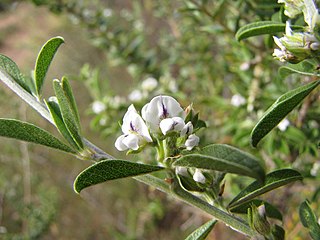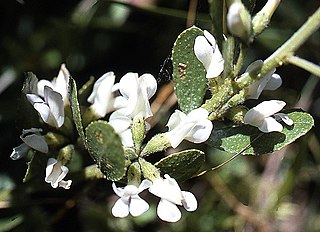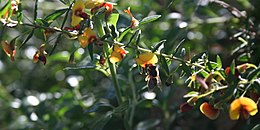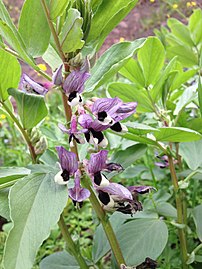
The Fabaceae or Leguminosae, commonly known as the legume, pea, or bean family, are a large and agriculturally important family of flowering plants. It includes trees, shrubs, and perennial or annual herbaceous plants, which are easily recognized by their fruit (legume) and their compound, stipulate leaves. The family is widely distributed, and is the third-largest land plant family in number of species, behind only the Orchidaceae and Asteraceae, with about 765 genera and nearly 20,000 known species.

Petals are modified leaves that surround the reproductive parts of flowers. They are often brightly colored or unusually shaped to attract pollinators. All of the petals of a flower are collectively known as the corolla. Petals are usually accompanied by another set of modified leaves called sepals, that collectively form the calyx and lie just beneath the corolla. The calyx and the corolla together make up the perianth, the non-reproductive portion of a flower. When the petals and sepals of a flower are difficult to distinguish, they are collectively called tepals. Examples of plants in which the term tepal is appropriate include genera such as Aloe and Tulipa. Conversely, genera such as Rosa and Phaseolus have well-distinguished sepals and petals. When the undifferentiated tepals resemble petals, they are referred to as "petaloid", as in petaloid monocots, orders of monocots with brightly colored tepals. Since they include Liliales, an alternative name is lilioid monocots.

The stamen is the pollen-producing reproductive organ of a flower. Collectively the stamens form the androecium.

Erythrina crista-galli, also known as the cockspur coral tree or ceibo, is a species of flowering tree in the family Fabaceae, native to Argentina, Uruguay, southern Brazil and Paraguay. It is widely planted as a street or garden tree in other countries, notably in California. Its specific epithet crista-galli means "cock's comb" in Latin.

A flower, also known as a bloom or blossom, is the reproductive structure found in flowering plants. Flowers consist of a combination of vegetative organs – sepals that enclose and protect the developing flower, petals that attract pollinators, and reproductive organs that produce gametophytes, which in flowering plants produce gametes. The male gametophytes, which produce sperm, are enclosed within pollen grains produced in the anthers. The female gametophytes are contained within the ovules produced in the carpels.

Cladrastis kentukea, the Kentucky yellowwood or American yellowwood, is a species of Cladrastis native to the Southeastern United States, with a restricted range from western North Carolina west to eastern Oklahoma, and from southern Missouri and Indiana south to central Alabama. The tree is sometimes also called Virgilia.
This page provides a glossary of plant morphology. Botanists and other biologists who study plant morphology use a number of different terms to classify and identify plant organs and parts that can be observed using no more than a handheld magnifying lens. This page provides help in understanding the numerous other pages describing plants by their various taxa. The accompanying page—Plant morphology—provides an overview of the science of the external form of plants. There is also an alphabetical list: Glossary of botanical terms. In contrast, this page deals with botanical terms in a systematic manner, with some illustrations, and organized by plant anatomy and function in plant physiology.
This glossary of botanical terms is a list of definitions of terms and concepts relevant to botany and plants in general. Terms of plant morphology are included here as well as at the more specific Glossary of plant morphology and Glossary of leaf morphology. For other related terms, see Glossary of phytopathology, Glossary of lichen terms, and List of Latin and Greek words commonly used in systematic names.
Barbieria is a genus of flowering plants in the legume family, Fabaceae. It contains a single species, Barbieria pinnata, a climber native to the tropical Americas, from southern Mexico through Central America and the Caribbean to northern South America.
Trifolium breweri, which has the common names forest clover and Brewer's clover, is a perennial clover that is native to mixed evergreen forests and coastal coniferous forests in Southern Oregon and California.

Sesbania punicea is an ornamental shrub with reddish-orange flowers. It has deciduous leaves and grows to a height of 15 feet. This plant has a high demand for water, and thrives in swamps or wet areas. It requires a mildly acidic soil, with a pH between 6.1 and 6.5.
Otholobium dreweae is an upright shrublet assigned to the Pea family of about 15 cm (5.9 in) high, that appears after the vegetation burned down from the underground rootstock and forms mat-like clumps of hardly branching, leafy stems. The stems are set with stiff, entire, alternate leaves with a single leaflet and heads consisting of 12-18 initially dark pink, later white, pea-like flowers with a white nectar guide on a peduncle as long as the leaves at the end of the stem. This species is an endemic of the Kleinrivier Mountains in the Western Cape province of South Africa. It mostly flowers in November.
Otholobium accrescens is an upright, largely herbaceous subshrub assigned to the Pea family. It has up to three stems that carry upright branches in leaf axils near the ground, and have alternately set inverted egg-shaped leaves and lax heads consisting of 12-21 pea-like flowers on long peduncles in the axils of the lower leaves. It differs from most other Otholobium species by the calyx that continues to grow after flowering and the leaf that consists of just one leaflet. It is an endemic of the Eastern Cape province of South Africa near Loerie. It probably flowers August to January.

Otholobium nitens is an upright, densely branched shrub of up to 1.5 m high that is assigned to the Pea family. It has one to many initially softly hairy stems, alternately set, clover-like, upright leaves crowding the new shoots, and heads consisting of 3 pea-like, dark purple to mauve flowers on short peduncles in the axils of the leaves on short side-shoots. This species is an endemic of the mountains between Ceres and Hottentots Holland in the Western Cape province of South Africa. It mostly flowers between October and late December.

Lobostemon is a genus of flowering plants belonging to the family Boraginaceae. It is endemic to the Cape Provinces of South Africa. The majority of species are limited to the winter rainfall area of the country, from Springbok to Mossel Bay. In Afrikaans these species are known as agtdaegeneesbos, or loosely translated, bush that will heal in eight days. As this name suggests, many species have medicinal properties. This is best known from Lobostemon fruticosus, which is used for treating wounds, blood poisoning, ringworm, skin diseases and syphilis.

Otholobium saxosum is a small shrublet of up to 20 cm (7.9 in) high that has been assigned to the Pea family, with branches upright or horizontal at the base with rising tips. It has sessile, clover-like leaves and white, pea-like flowers that grow in triplets in the axils of the upper leaves of new, short side shoots. The species is only known from Garcia's Pass in Western Cape province of South Africa. Flowering occurs in October and November.

Otholobium spissum is a dense, tangled, much branched shrub of up to 185 cm (73 in) high that is assigned to the Pea family. It has dull green, clover-like leaves and white, pea-like flowers with a streaky, triangular, purple nectar guide. The species grows in renosterveld in the central mountains of the Western Cape province of South Africa. This species flowers in July and August.

Otholobium lucens is a shrub of up to 60 cm (24 in) high that is assigned to the pea family. It has alternately set clover-like leaves crowding on the new growth, while older parts have lost their leaves. The white, pea-like flowers occur with 3 or 6 together in the leaf axils. This rare species is an endemic of the Swartberg mountains in the Western Cape province of South Africa. It flowers between July and February.
Otholobium piliferum is a small, softly hairy shrublet of up to 30 cm (12 in) high that has been assigned to the Pea family, with branches horizontal at the base with rising tips. It regrows from the underground rootstock after fire destroys the vegetation. It has clover-like leaves on short stalks and white, pea-like flowers flushed with mauve that grow in triplets in the axils of the upper leaves of the new shoots. The species is only known from near Makhanda, Eastern Cape province of South Africa. Flowers have been seen in September and January. This is a very rare species about which little is known and which is likely threatened with extinction.

In botany, floral morphology is the study of the diversity of forms and structures presented by the flower, which, by definition, is a branch of limited growth that bears the modified leaves responsible for reproduction and protection of the gametes, called floral pieces.



















